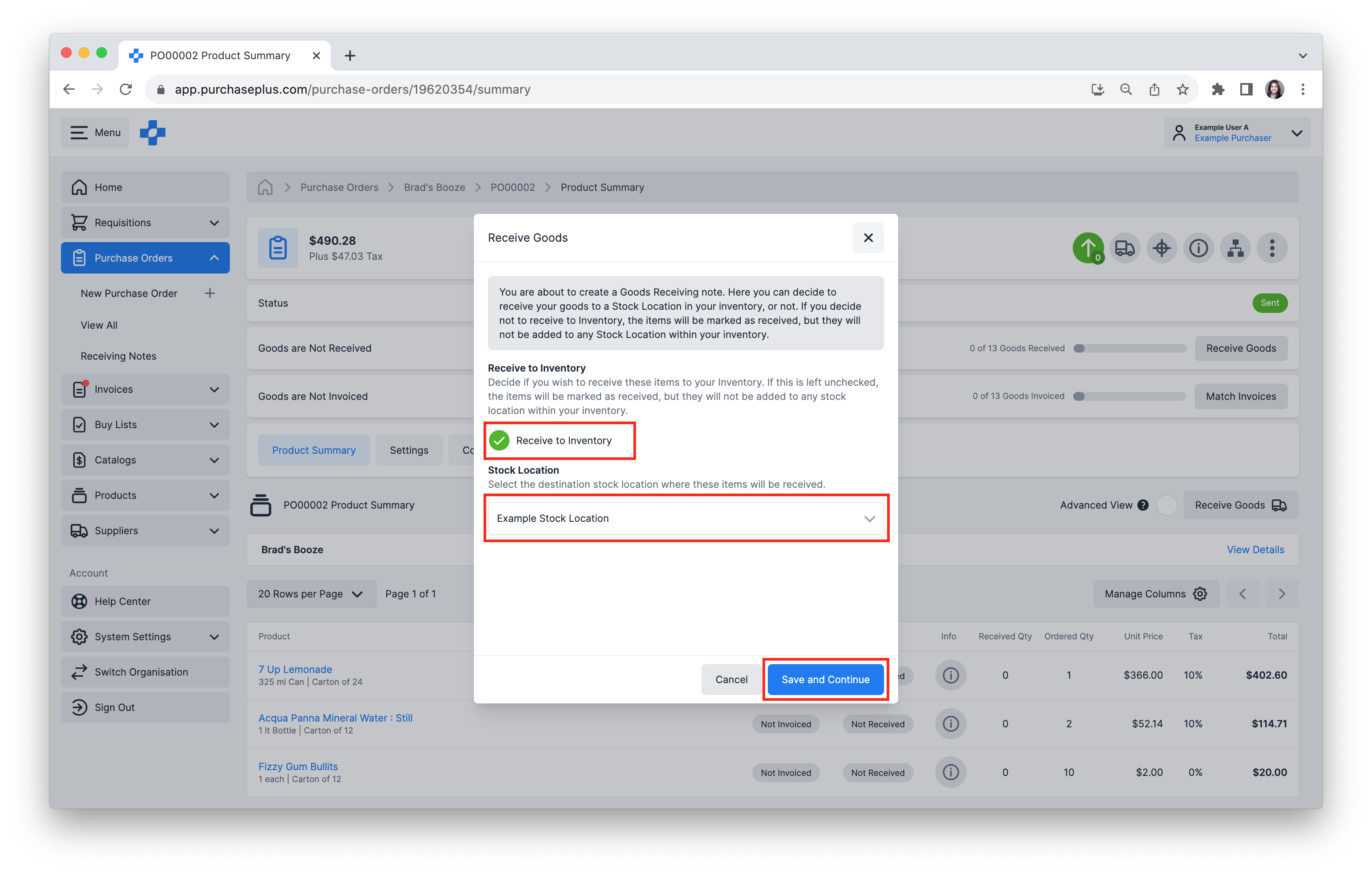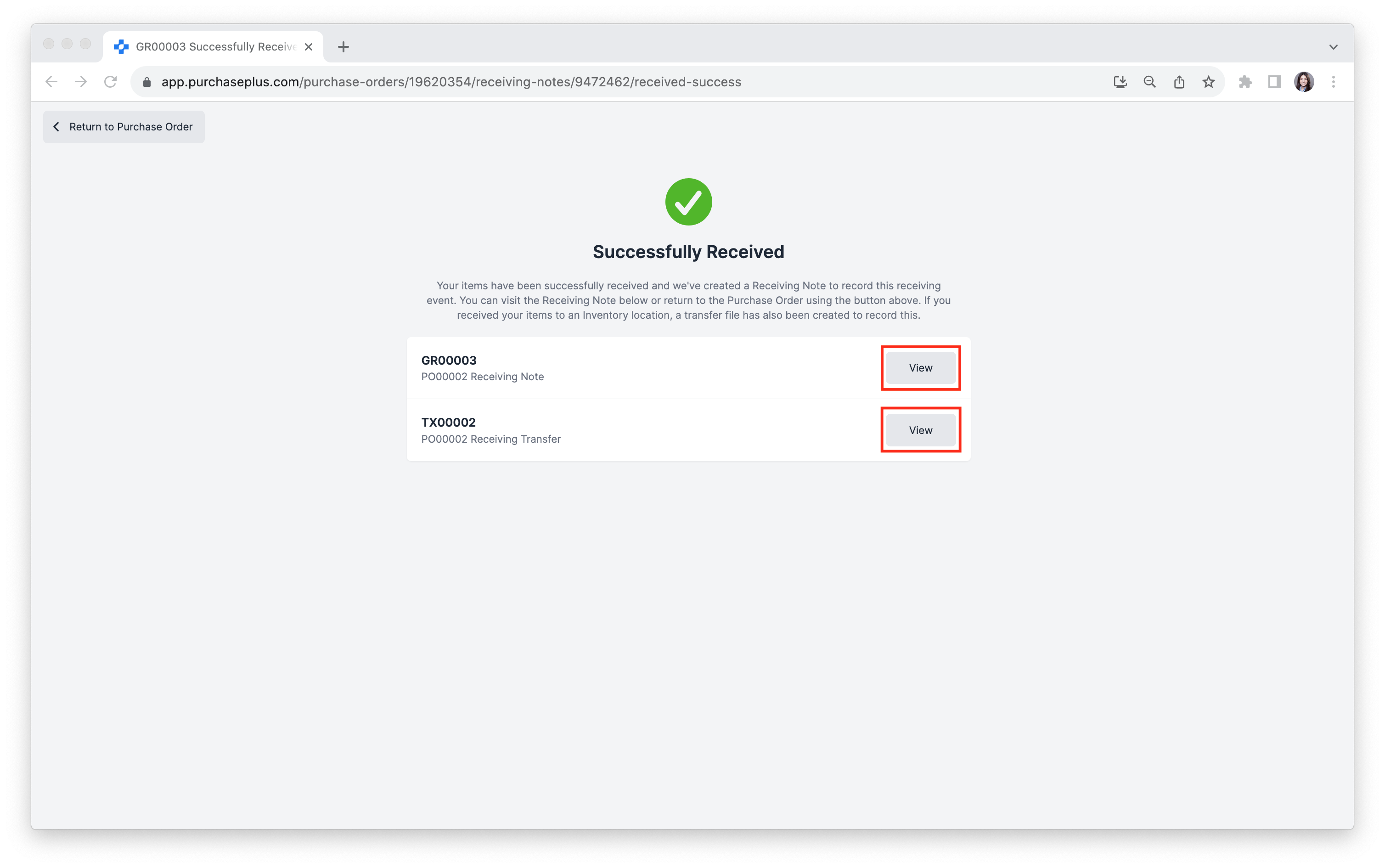Learn how to create a Goods Receiving Note and Receive Goods from a Purchase Order.
Marking Purchase Order line items as Received tells users at your Organisation when a Purchase Order can be closed.
It is also crucial for processing Invoices if your Organisation has opted for 3-Way AP Matching; That is, the Invoice lines are cross-checked against what was ordered (from the Purchase Order) and what was received (on the Goods Receiving Note), before being able to be Reconciled.
Skip to:
- Creating a Goods Receiving Note
- Manaing a (Draft) Goods Receiving Note
- Completing a Goods Receiving Note
Create a Goods Receiving Note
To create a new Goods Receiving Note, navigate to to [Purchase Orders] → [View All], from the side navigation bar. Click the [Truck] icon in the GR Note column, to create a Goods Receiving Note against the Purchase Order.
Alternatively, you can click into a Purchase Order, and select one of the [Receive Goods] buttons found within the Purchase Order.
Receive to Inventory
If your Organisation is using the Inventory Module, you will be presented with the option to receive the Goods to a Stock Location within Inventory, so that your Stock Levels in that Stock Location are updated accordingly.
First, tick the [Receive to Inventory] checkbox and select the Stock Location where the items will be Received. Click [Save and Continue].

You will be prompted to match the items that you are Receiving to existing Stock Items. If only a single Stock Item exists that appropriately matches the item being received, then this Stock Item will be pre-selected for the you. If no appropriate match exists, you can create a new Stock Item:
Receive All Outstanding Items
You can Pre-Fill a Goods Receiving Note with the outstanding quantities on the Purchase Order. This is an extremely powerful time-saving feature, allowing you to greatly accelerate the Goods Receiving process, so that even the lengthiest Purchase Order can be marked as Fully-Received in just a few clicks. Please note, this feature is not available when Receiving to Inventory, as the process of matching to Stock Items must be completed first.
First, navigate to the Purchase Order in question, and click [Receive Goods] as above. Check the [Receive All Outstanding Items] checkbox, and then [Save and Continue]:
 Every outstanding line item on the Purchase Order, whether is has previously been Partially Received or not, will be pre-filled as a Fully-Received line on the resulting Goods Receiving Note. You then have the opportunity to edit the quantities of the goods being Received, or completing the Goods Receiving Note by clicking [Mark as Received].
Every outstanding line item on the Purchase Order, whether is has previously been Partially Received or not, will be pre-filled as a Fully-Received line on the resulting Goods Receiving Note. You then have the opportunity to edit the quantities of the goods being Received, or completing the Goods Receiving Note by clicking [Mark as Received].
Managing a Draft Goods Receiving Note
As soon as you click [Receive Goods] on a Purchase Order, a Draft Goods Receiving Note is created. You can complete the following actions as required, or you can click [Save as Draft] to return to the previous screen.
a) Adjust the Receiving Quantity of any item on the Goods Receiving Note.
b) Access Advanced Options to:
- View a summary of Quantities,
- View Linked Invoice Lines,
- Override Receiving Unit Price. This is a fairly-common scenario, arising when the Receiving Price is different to the Purchase Order Line Price (or the Invoice Line, if it is already Linked with an Invoice). Please see our article: Override Unit Price when Receiving for more information.
- Enter line item Comment,
- Record Product Expiry Date,
- Record Vehicle Temperature,
- Record Product Temperature.
c) [Add a Product]. This is helpful when, for example, you need to Receive an ad-hoc product that arrived with the delivery, but was not listed on the Purchase Order.
d) [Show or Hide Details] of Receiving Note.
e) [More Options], allowing you to:
- [View Audit Log]
- [Open in Legacy P+]
- [Cancel Receiving Note]
- [Get Help].
f) [Mark as Received]. Click this button when you have finished editing the Goods Receiving Note and you are satisfied with the data that will be saved.
g) Access the [Settings] tab of the Goods Receiving Note.
h) You can hide Already Received items by clicking [Hide Already Received Items] towards the top of the page:
Completing a Goods Receiving Note
Clicking [Mark as Received] on a Draft Goods Receiving Note will transition the draft document to a 'RECEIVED' state.
You will first arrive on a confirmation page, where you can click the [View] button to view the completed Receiving Note. If the delivery was Received to Inventory, you will also see a link to any Transfer Notes created.
The Receiving Note will be saved permanently in the Receiving Notes tab of the Purchase Order that it belongs to:




